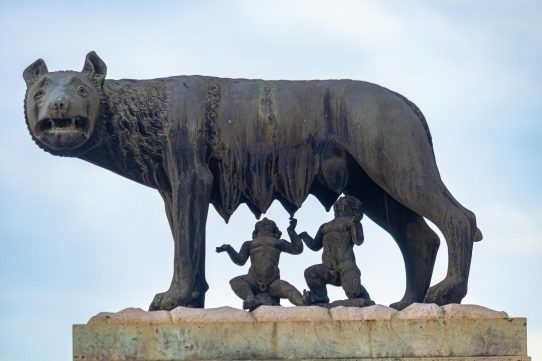In the earliest chapters of Rome’s legendary past, before the rise of emperors, before the Senate shaped the destiny of an expanding republic, and before Roman values crystallized into the ideals we recognize today, there lived a figure whose name became synonymous with treachery.
Tarpeia, a Vestal-born maiden or a commander’s daughter depending on the tradition, occupies a unique place in the Roman mythic imagination. Her story is not one of triumph or loyal devotion but one of greed, deception, and the harsh consequences that followed.
Tarpeia’s tale unfolds during the conflict between the Romans and the Sabines, a pivotal moment in Rome’s mythological history. At its center was the Capitoline Hill, a steep and fortified position from which the young Roman kingdom guarded its growing power. It was here that Tarpeia lived, and it was here that she made the fateful decision that ultimately marked her as Rome’s first and most infamous betrayer.
The Setting: Rome in Its Earliest Days
According to Roman tradition, the drama surrounding Tarpeia occurred shortly after the founding of Rome by Romulus. Tensions between the Romans and Sabines had escalated after the famous episode known as the “Rape of the Sabine Women,” in which Roman men carried off Sabine women to become their wives. Although the women themselves would later advocate for peace, a full-scale conflict erupted before reconciliation was possible.
The Sabines, led by King Titus Tatius, sought to reclaim their daughters and punish Rome for its bold raid. Yet assaulting the Capitol directly was nearly impossible. Its cliffs were steep, its entryways fortified, and its defenses seemingly impregnable. The Romans felt confident that the high ground would shield them from a Sabine invasion.
But their security would be undone from the inside.
Tarpeia’s Background: Daughter of a Guardian
Tradition holds that Tarpeia was the daughter of Spurius Tarpeius, commander of the Capitol’s guard. Growing up in the fortress, she would have known every locked gate, every hidden path, and every point where the defenses were weakest. Some versions call her a Vestal Virgin, though this may be a later embellishment meant to intensify the shame of her betrayal.
However her upbringing is described, all accounts agree on two things: she had access to the Capitol, and her actions would decide the course of the war.
The Bargain: Gold for Passage
Tarpeia’s moment of weakness came when she encountered Sabine soldiers wearing magnificent bracelets and golden armlets upon their shield arms. Whether she was dazzled by the glitter of their jewelry or moved by a darker desire for recognition, Tarpeia approached the Sabines with an offer. She would open the gates of the Capitol to them if they gave her “what they wore on their arms.”
Her phrasing, deliberately ambiguous or naïve depending on the storyteller, sealed her fate.
The Sabines agreed.
One night, Tarpeia secretly opened a hidden gate or pathway to allow the Sabine warriors entrance onto the Capitol. Their shields scraped across stone. Their spears glinted in the torchlight. Rome’s most secure stronghold had been breached, not through force but through the greed of a single insider.
What happened next is the defining moment of the legend.
Betrayed by Her Own Bargain
When the Sabine soldiers met Tarpeia to deliver the reward she believed she deserved, they interpreted her request literally. She had asked for “what they wore on their arms.” But she had meant gold and jewelry.
They gave her their shields.
Heavy, bronze, and deadly when hurled in unison, the Sabines’ shields crashed down upon Tarpeia, crushing her beneath their weight. Buried under a mound of metal, she became a silent warning to all who witnessed or later heard of her fate.
Her death marked her not as a victim but as the embodiment of treachery punished. The Romans, even in defeat, would not mourn her.
The Tarpeian Rock: Monument of Shame
The place where Tarpeia died became known as the Tarpeian Rock, a steep cliff on the Capitoline Hill overlooking the Forum. From the early days of the Republic onward, this cliff served a grim purpose. Criminals guilty of treason or serious offenses were taken to its edge and cast down to their deaths.
Romans remembered Tarpeia not in honor but in condemnation. Her name became a symbol of betrayal, her story a moral lesson passed from generation to generation. To betray the homeland was to share Tarpeia’s fate.
The proverb “The Tarpeian Rock is near the Capitol” emerged as a reminder that power and ruin often sit dangerously close to one another.
Interpretations Across the Ages
Though the core of her story remains consistent, many variations seek to reinterpret Tarpeia’s motives and character.
Some portray her as greedy, driven by the allure of Sabine gold. Others suggest she acted under coercion or believed the Sabines would reward her with a political alliance. In a more sympathetic reading, Tarpeia may have attempted to trick the Sabines, counting on their jewelry rather than their shields, only to be naive about the potential consequences.
A minority of ancient authors even cast her as a patriot: a double agent who intended to disarm the Sabines by asking them for their shields, thus aiding Rome’s defense. But these interpretations are exceptions rather than the norm and usually dismissed by historians of myth.
The prevailing view remains unchanged: Tarpeia embodies the Roman lesson that treachery against the state cannot go unanswered.
Cultural Significance and Lasting Legacy
Tarpeia’s legend endured not simply because it was dramatic but because it aligned with Rome’s core values. Loyalty to the state, devotion to one’s duties, and the prioritization of collective well-being over personal gain were central Roman virtues. Tarpeia violated all of them.
Her story reinforced the belief that betrayal was the gravest moral failure a Roman could commit. From historians like Livy to poets such as Propertius, Tarpeia appeared frequently in literature, always as a cautionary figure. Her memory was woven into festivals, rituals, and political speeches. The Tarpeian Rock served as a permanent physical reminder of her actions and their consequences.
In the broader landscape of Roman mythology, Tarpeia stands apart. She is not a goddess, not a heroine, not a tragic victim shaped by divine forces. She is an ordinary mortal who made a ruinous choice and paid the price. And it is precisely this humanity that makes her legend so enduring.
Tarpeia’s Story as Moral Instruction
For Roman writers, Tarpeia’s tale was a tool for shaping societal behavior. Her downfall warned against compromising honor for personal gain. It reminded citizens that the strength of Rome rested not only on its walls or its armies but on the fidelity of its people.
In a city where betrayal could topple a government or collapse a nation’s defenses, Tarpeia represented the ultimate danger: the traitor within. Her memory served as both deterrent and lesson.
Today, her story continues to be studied not only for its dramatic elements but for what it reveals about Roman culture. The Romans understood that the greatest threats often come from those trusted to protect, and Tarpeia’s legacy stands as one of the earliest and most vivid illustrations of that truth.








